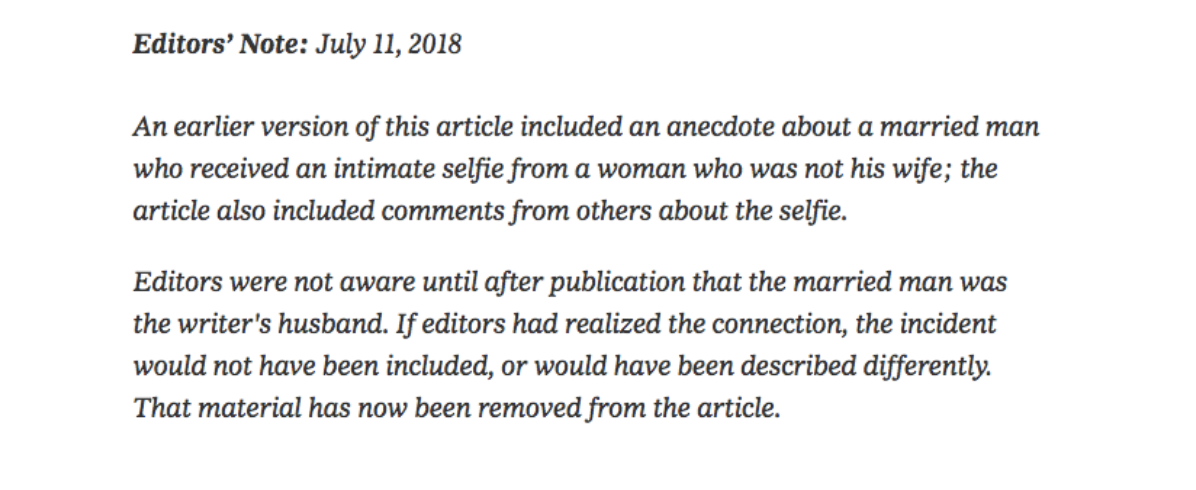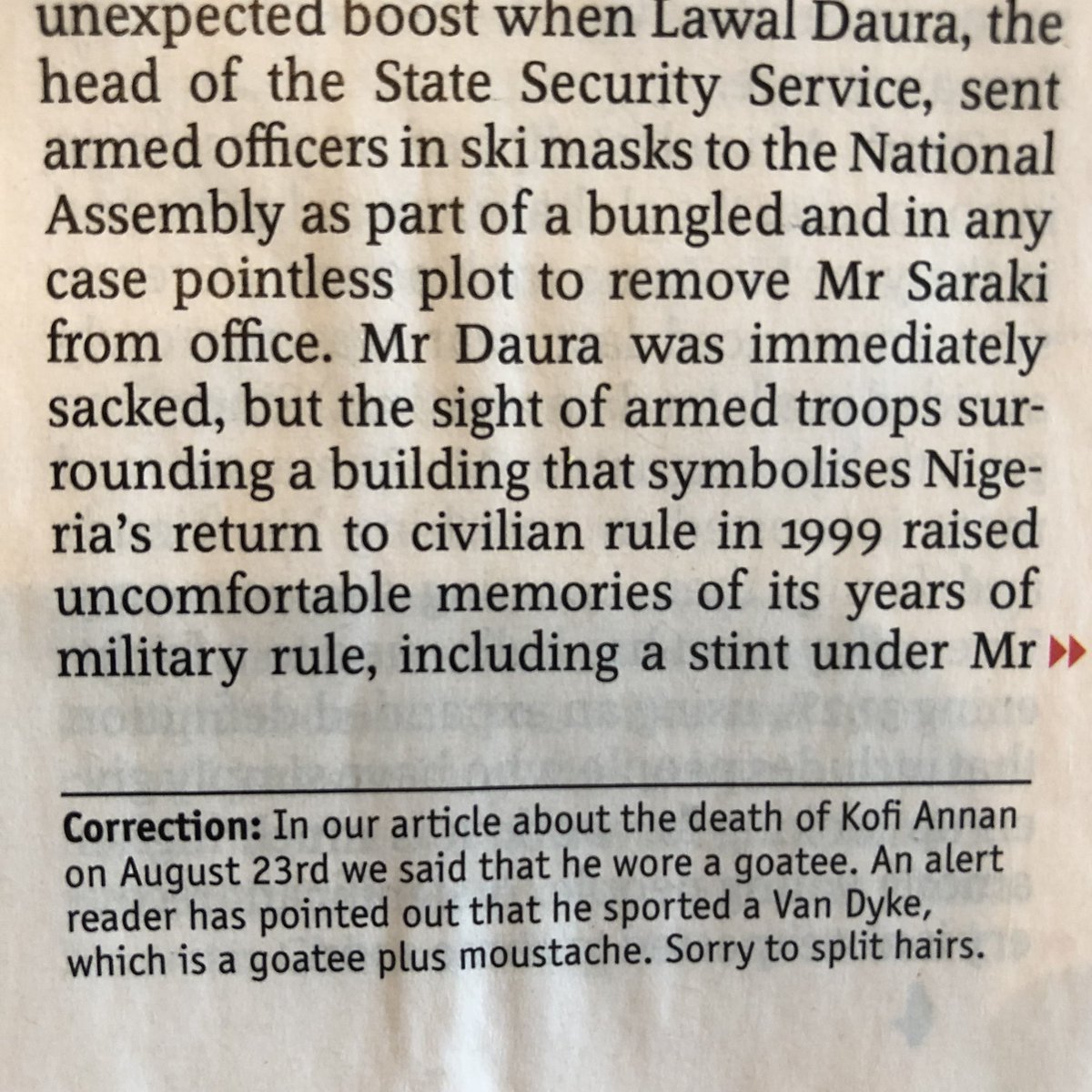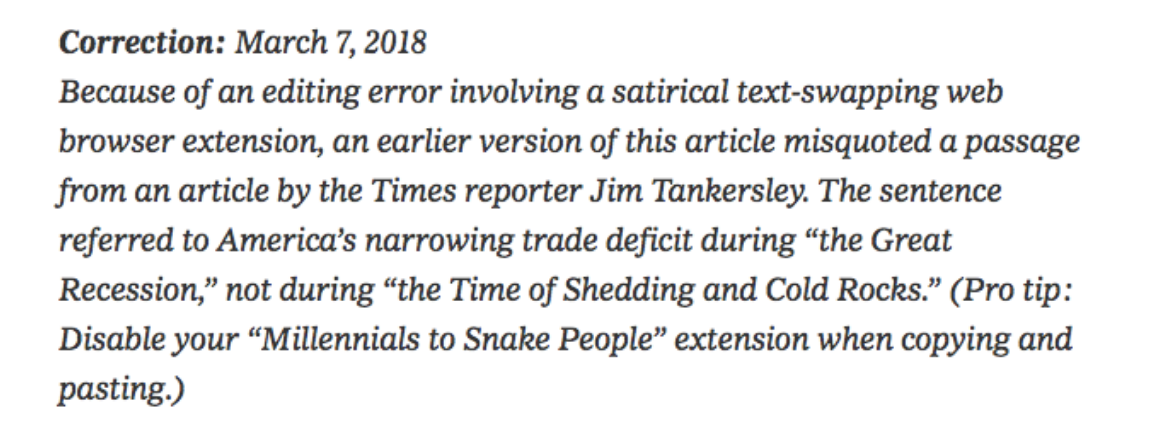No one likes admitting to a mistake. But everyone likes reading about them.
Poynter’s annual roundup of media corrections is now in its sixth edition (follow the links for 2013, 2014, 2015 and 2016 and 2017 lists) — and it is always among our top articles of the year.
The corrections in our roundup are often hilarious, uncovering Freudian slips, misplaced homonyms or pedantic readers. But not all are a laughing matter. Corrections can reveal systemic bias or severe mispractice in reporting.
Still, readers should continue to value publications that honestly correct themselves over those that pretend nothing happened or stealthily edit past mistakes. Corrections policies are an unequivocally good thing about journalism. Even as accusations of “fake news” dog the industry, its response should be to double down on this practice.
Do you have a correction you think we should include? Email alexios@poynter.org.
The funny
I hate to get all political here, but I’d vote for the Toy Story guy over the Leo Tolstoy guy.
A correction for the ages, by Brazilian news magazine Veja
"The candidate likes to spend his free time reading Tolstoy, and not watching Toy Story, as originally reported" https://t.co/qKcKbsyFYw
— Cleuci de Oliveira (@CLEUCl) September 7, 2018
Even if you don’t love the saxophone, this feels a little extreme (from the Morning Star).
My new favourite newspaper correction pic.twitter.com/wGaFcuAMeh
— Paul Cunningham (@cunninghampaul) August 2, 2018
I’m still working on a suitable pun involving this error and a Britney hit but all I can think about is how millennials “killed tuna.”
A most excellent celebrity name misspelling in the WSJ pic.twitter.com/FpOllQrvtE
— Craig Silverman (@CraigSilverman) October 6, 2018
This really rubbed the facial hair lobby the wrong way (from The Economist).
Look, recipes are a map, not a rulebook (The Guardian both times).
Rising house prices have led some San Franciscans to commute from Seattle, so maybe this Washington Post correction is just a glimpse of the future for Brooklynites.
The question left unanswered here is: Will the robots eat the Oreo?
CORRECTION
Sidd Srinivasa said "Twisting open an Oreo is one of the hardest problems of robotic technology" — a previous tweet incorrectly quoted him saying it was "one of the hottest products."
The social media producer, Brie Ripley, regrets the error.
— KUOW Public Radio (@KUOW) July 10, 2018
Some people might think that confusing Stan Lee and Spike Lee is the howler here but The Gisborne Herald in New Zealand screwed up the winner of the “people’s choice award for dogs that look like their owners”?? Unsubscribe.
Wow the AP is going to hear it from some woodwind enthusiasts.
(If you’re one of them, here’s the Pipers’ “Wake Me Up” cover. The commenter who writes “They really changed their sound after John left” deserves an award.)
What possible use does this plugin have (The New York Times)?
Iraq would have been pretty impressive, too, given how far it was from Kadesh.
An absolutely beautiful @WSJ correction today. Happy Passover! pic.twitter.com/U8W2sO6Dus
— Amy Spiro (@AmySpiro) March 28, 2018
Speaking of Judaism (AP)… This one’s on the machine. Darn CMS.
This one’s on the machine. Darn CMS.
https://t.co/CxsVLHFPGq pic.twitter.com/XRNOiKTAEk
— Kristen Hare (@kristenhare) May 6, 2018
Not a jumble fan so I’m not sure what any of this means. Can someone help me out?
https://twitter.com/dsorbara/status/1027875135733280768
Weird
Isn’t nature majestic?
Oh https://t.co/AzIzqy9Fz3 pic.twitter.com/fiKM7SxmEz
— erin mccann | (@mccanner) July 20, 2018
Warning, we’ve officially entered the NSFW section of this roundup.
I have made a mistake, and as a journalist, I must apologize. https://t.co/dYqW6d1OxB pic.twitter.com/jrrhKZMky0
— julia reinstein
(@juliareinstein) September 18, 2018
Speaking about sexual proclivities (The New York Times).
 Following an IPSO ruling, The Daily Mirror had to clarify that a right-wing columnist was arrested for spreading hate, not drugs.
Following an IPSO ruling, The Daily Mirror had to clarify that a right-wing columnist was arrested for spreading hate, not drugs. A bizarre turn in a bizarre dispute in American politics over Native American heritage warrants a bizarre correction from The Boston Globe.
A bizarre turn in a bizarre dispute in American politics over Native American heritage warrants a bizarre correction from The Boston Globe.
Not saying the editors of this article definitely don’t know how the baby-making business works but how did it take two corrections to get it right? (Flashback to Aleppo, “the capital of Syria”.)
https://twitter.com/passantino/status/1058519205916504064?s=11
The serious
ProPublica published a very long correction to its inaccurate report that the incoming CIA director Gina Haspel had overseen a clandestine base where an Al Qaeda leader had been waterboarded. As the investigative outfit’s editor-in-chief stressed, this was a big mistake:
“We at ProPublica hold government officials responsible for their missteps, and we must be equally accountable. This error was particularly unfortunate because it muddied an important national debate about Haspel and the CIA’s recent history.”
The newsroom’s response to the error is a masterclass on how corrections should be conducted. It shed light on the reporting process that led to the mistake.
“Our account of Haspel’s actions was drawn in part from declassified agency cables and CIA-reviewed books which referred to the official overseeing Zubaydah’s interrogation at a secret prison in Thailand as “chief of base.” The books and cables redacted the name of the official, as is routinely done in declassified documents referring to covert operations.
The Trump administration named Haspel to the CIA’s No. 2 job in early February 2017. Soon after, three former government officials told ProPublica that Haspel was chief of base in Thailand at the time of Zubaydah’s waterboarding.
…
James Mitchell, the psychologist and CIA contractor who helped to direct the waterboarding of both suspects, said in a broadcast interview on March 14 that Haspel was not the “chief of base” whom he described in his book as making fun of Zubaydah’s suffering.
…
Mitchell’s book, “Enhanced Interrogation: Inside the Minds and Motives of the Islamic Terrorists Trying to Destroy America,” referred to the chief of base in Thailand as both “he” and “she.”
We erroneously assumed that this was an effort by Mitchell or the agency to conceal the gender of the single official involved; it is now clear that Mitchell was referring to two different people.
ProPublica contacted Mitchell in 2017 to ask him about this passage in his book. Facing a civil lawsuit brought by former CIA detainees, he declined to comment.
…
The awkward communications between officials barred from disclosing classified information and reporters trying to reveal secrets in which there is legitimate public interest can sometimes end in miscommunication. In this instance, we failed to understand the message the CIA’s press office was trying to convey in its statement.”
What seemed like a scoop combining two very contentious storylines — ICE’s treatment of immigrants and Facebook’s tracking of private data — led to very significant correction on The Intercept.
That @theintercept story about Facebook used by ICE to track immigrants that went pretty viral? It wasn't an immigrant. It was a legal subpoena on a child exploitation/abuse case. (Incredible correction at the end!!!) Motivated reasoning isn't just a right-wing phenomenon. 1/x pic.twitter.com/YcEds9exkk
— zeynep tufekci (@zeynep) March 27, 2018
The next four corrections make it into the “serious” category because they exhibit behaviors like miscaptioned photos, unvetted user-generated content or satire taken as genuine news that, as an industry, we have spent time stressing are markers of “fake news” operations.
For instance, The Arizona Republic used photos from 2014 to depict the situation of immigrant children at detention facilities.
Photos of children at a migrant holding facility have gone viral on social media. The pictures are from 2014. They were originally posted with this azcentral article about unaccompanied migrant children who were transported to a facility in Arizona. https://t.co/2DXdszR0SU
— azcentral (@azcentral) May 27, 2018
And Fox News had to apologize for using entirely irrelevant footage of Philadelphia Eagles players kneeling during prayer while commenting on the controversy over football players kneeling during the National Anthem.
Fox News apologizes for showing “unrelated footage” of Eagles “players kneeling in prayer.” Full statement below from Christopher Wallace, executive producer of Fox News Night with Shannon Bream: pic.twitter.com/3IfHURmpux
— Michael Calderone (@mlcalderone) June 5, 2018
ABC News (and many others) fell hook, line and sinker for a feel-good false story about Croatian firefighters missing the key goal of their national team at the FIFA World Cup to respond to a call for help.
The below tweet has been deleted after learning it is not clear if this event took place during the referenced World Cup match. pic.twitter.com/WeeyzMhErO
— ABC News (@ABC) July 14, 2018
The Washington Post legit quoted an “op-ed” allegedly published by Billie Joe Armstrong of Green Day on the satirical website Clickhole in an article about “American Idiot.”
*Ahem*
This story has been updated to remove material attributed to a satirical Web publication, Clickhole. https://t.co/qxLXFS84Pw
— The Washington Post (@washingtonpost) July 10, 2018
The New York Times had to dramatically change its headline on an article about the cost of curtains at the residence of the U.S. Ambassador to the United Nations. The $52,000 price tag had caused several people to criticize Nikki Haley, who had not made the decision in question.
Finally, there were a disappointing number of stories that used the wrong photos for black public figures over the course of 2018.
The New York Times miscaptioned a photo of actress Angela Bassett as former Trump adviser Omarosa Manigault-Newman:
We regret running an incorrect caption from a photo wire service in some early print editions. We will issue a correction in tomorrow's paper.https://t.co/fEezxxXo0M
— NYTimes Communications (@NYTimesPR) September 18, 2018
Scores of media outlets used a photo of an unidentified black woman to accompany their obituaries of Linda Brown (of Brown v. Board of Education).
https://twitter.com/Mantzarlis/status/992027748981006340
The Hill confused the first black woman to hold the post of National Security Adviser with the second black woman to hold it. Both of their surnames are “Rice,” too.
Er… @thehill. That’s not Susan Rice. That’s Condoleezza. pic.twitter.com/I1yNjlLx8n
— Peter Jukes (@peterjukes) October 7, 2018
And Fox News used a photo of Patti LaBelle in a graphic on Aretha Franklin.
In September, Karen M. Turner, associate professor of journalism at Temple University, told Valerie Russ of the Philadelphia Inquirer that these types of mistakes likely stem from a lack of diversity in the newsroom.
As great as corrections are, responding to serious errors will require not just rectifying in an honest and complete manner but acknowledging they might flow from a systemic handicap — and working towards addressing it.
Correction: The article originally misspelled the name of the Philadelphia newspaper as “Enquirer.” The mix-up is a hangover from the author’s time in a British university. Many thanks to inquiring mind Eugene Kiely for spotting the mistake.

















